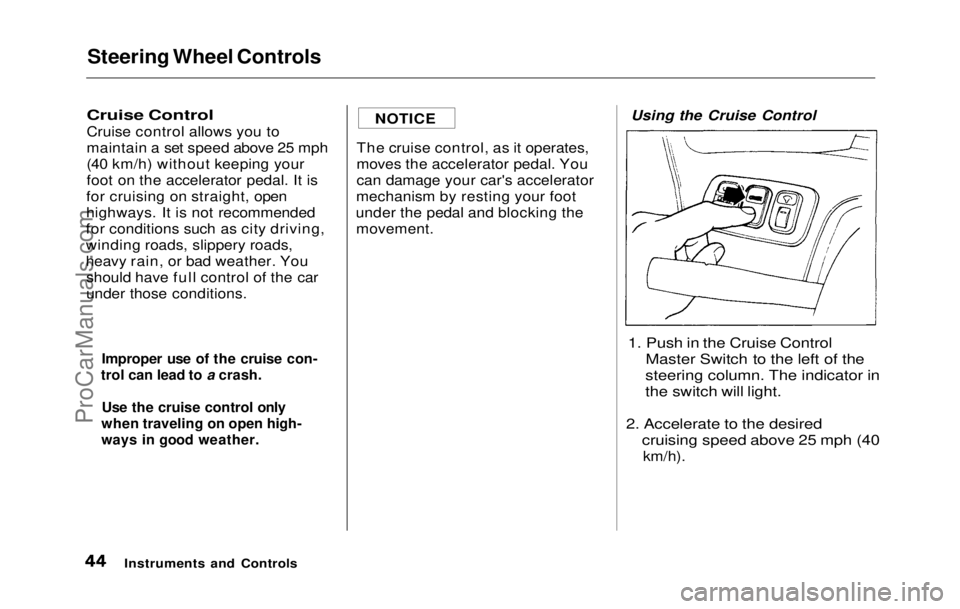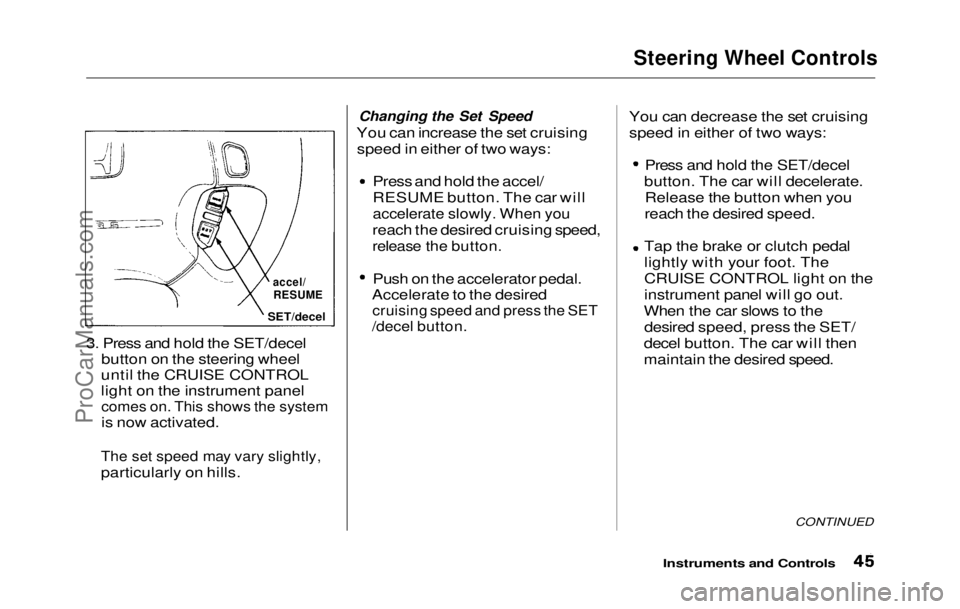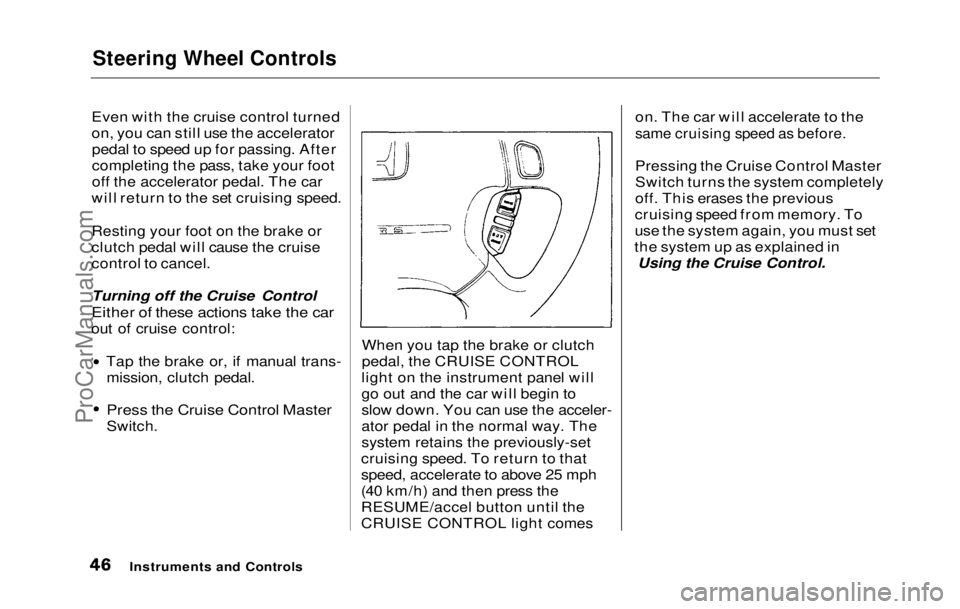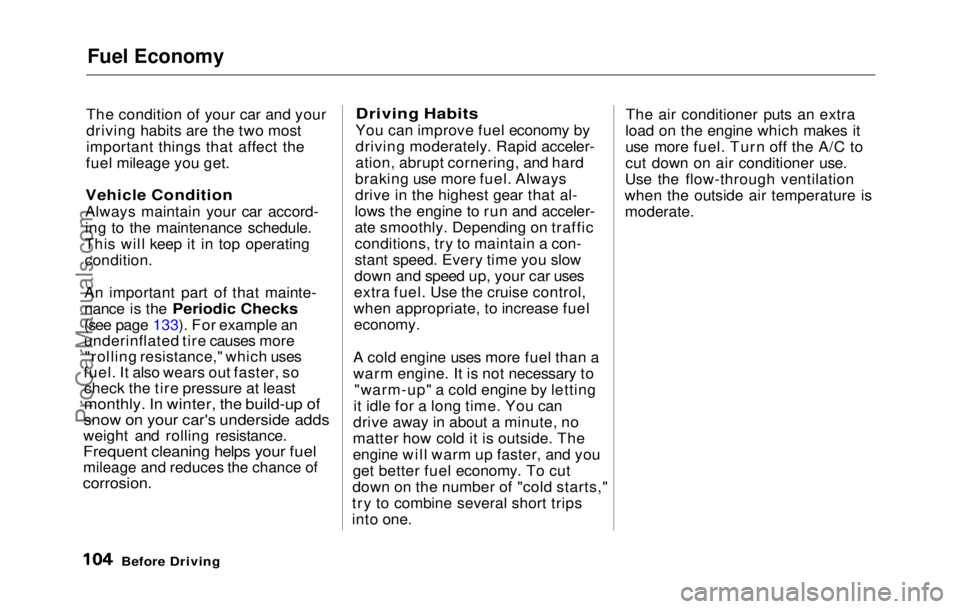1992 HONDA PRELUDE cruise control
[x] Cancel search: cruise controlPage 29 of 225

Instruments and Controls
This section gives information
about the controls and displays that
contribute to the daily operation of
your Honda. All the essential
controls are within easy reach.
Control Locations......................... 30
Indicator Lights.............................. 31
Gauges............................................. 37
Speedometer
.............................
37
Tachometer................................. 37
Odometer
.................................... 37
Trip Meter................................... 37
Fuel Gauge..................................
38
Temperature Gauge
..................
38
Controls Near the
Steering
Wheel
....................................... 39
Headlights................................... 40
Daytime Running Lights.......... 40
Instrument Panel Brightness... 41
Turn Signals................................ 41
Windshield Wipers.....................
42
Windshield Washers.................
42
Steering Wheel Adjustment ....
. 43
Steering Wheel Controls............... 44
Cruise Control............................ 44
Horn ............................................ 47
Keys and Locks.............................. 47
Keys.............................................. 47
Ignition Switch........................... 47
Door Locks.................................. 48
Power Door Locks ..................... 48
Trunk.......................................... 50
Seat Adjustments........................... 51
Rear Seat Access........................ 52
Additional Driver' s
Seat
Adjustments...........................
53
Seat Heaters.................................... 54
Folding Rea r
Seat.......................... 55
Hazard Warning............................ 56
Rear Window Defogger ................ 56
Power Windows.............................. 57
Sunroof ...........................................
58
Mirrors ........................................... 59
Parking Brake................................ .
61
Glove Box........................................
.
62
Digital Clock..................................
.
63
Center Console Compartment .... 64
Vanity
Mirror
..............................
64
Cigarette Lighter
..........................
.
65
Ashtray........................................... 65
Interior Lights...............................
.
66
Instruments an
d
ControlsProCarManuals.comMain Menu s t
Page 32 of 225

Indicator Lights
* The U.S. instrument panel is
shown. Differences for the Canadi-
an model are noted in the text.
Instruments and Controls
CRUISE CONTROL INDICATOR
LOW FUEL INDICATOR CHECK ENGINE LIGHT*
BRAKE LAMP
INDICATOR
TRUNK-OPEN INDICATOR DOOR-OPEN INDICATOR
LOW OIL PRESSURE LIGHT
CHARGING SYSTEM LIGHT SEAT BELT
REMINDER
LIGHT PARKING BRAKE
AND BRAKE
SYSTEM LIGHT* ANTI-LOCK BRAKE SYSTEM
INDICATORProCarManuals.comMain Menu Table of Contents s t
Page 35 of 225

Indicator Lights
Four Wheel Steering
System (4WS)
Indicator
Only on cars equipped with electronic
four wheel steering
This light normally comes on when you turn the ignition ON (II) and
goes off after the engine starts. If it
comes on at any other time, there is
a problem in the 4WS. If this
happens, stop the car in a safe placeand turn off the engine. Reset the
system by restarting the engine.
Watch the 4WS light. If it does not
go off, or comes back on again
while driving, take the car to yourdealer to have the system checked.
The 4WS system is disabled with this light on. The rear wheels are
locked straight ahead, and your car
steers like a conventional car
without 4WS.
Turn Signal and
Hazard Warning
Indicators
The left or right turn signal light
blinks when you signal a lane change or turn. If the light does not
blink or blinks rapidly, it usually
means one of the turn signal bulbs is burned out (see page 164).Replace it as soon as possible, since
other driver s
cannot see that you
are signaling.
When you turn on the Hazard
Warning switch, both turn signal
lights blink. All turn signals on the outside of the car should flash.
High Beam Indicator
This light comes on with the high
beam headlights. See page 40 for information on the headlight
controls.
Instruments and Controls
4WS
Low fuel Indicator
This light comes on as a reminder
that you must refuel soon.
Cruise Control
Indicator
This lights when you set the cruise control. See page 44 for informa-
tion on operating the cruise control.
Trunk-open Indicator
This light comes on if the trunk lid
is not closed tightly.
Door-open Indicator
This light comes on if either door is
not closed tightly.
CRUISE
CONTROL
ProCarManuals.comMain Menu Table of Contents s t
Page 39 of 225

Controls Near the Steering Wheel
The two levers on the steering column contain controls for driving
features you use most often. The
left lever controls the turn signals,
headlights, and high beams. The
right lever controls the windshield
wipers.
The controls on the dashboard to
the left of the steering column are
for the sunroof, cruise control and instrument panel brightness.
The lever on the underside of the steering column allows you to tilt
the steering wheel.
Instruments and Controls
INSTRUMENT PANEL
BRIGHTNESS WINDSHIELD WIPERS/WASHERS
CRUISE
CONTROL
HEADLIGHTS/
TURN SIGNALS
TILT ADJUSTMENT
HAZARD WARNING LIGHTSProCarManuals.comMain Menu Table of Contents s t
Page 44 of 225

Steering Wheel Controls
Cruise Control
Cruise control
allows you to
maintain a set speed above 25 mph
(40 km/h) without keeping your
foot on the accelerator pedal. It is
for cruising on straight, open
highways. It is not recommended
for conditions such as city driving,
winding roads, slippery roads,
heavy rain, or bad weather. You should have full control of the car
under those conditions. The cruise control, as it operates,
moves the accelerator pedal. You
can damage your car's accelerator
mechanism by resting your foot
under the pedal and blocking the movement. Using the Cruise Control
1. Push in the Cruise Control
Master Switch to the left of the
steering column. The indicator in
the switch will light.
2. Accelerate to the
desired
cruising speed above 25 mph (40
km/h).
Instruments an d
Controls
Improper use of the cruise con-
trol can lead to a crash.
Use the cruise control only
when traveling on open high-
ways in good weather.
NOTICEProCarManuals.comMain Menu Table of Contents s t
Page 45 of 225

Steering Wheel Controls
3. Press and hold the SET/decel button on the steering wheel
until the CRUISE CONTROL
light on the instrument panelcomes on. This shows the system
is now activated.
The set speed may vary slightly,
particularly on
hills.
Changing the Set Speed
You can increase the set cruising speed in either of two ways:
Press and hold the accel/
RESUME button. The car will
accelerate slowly. When you
reach the desired cruising speed,
release the button.
Push on the accelerator pedal.
Accelerate to the desired
cruising speed and press the SET
/decel button.
Yo
u can decrease the set cruising
speed in either of two ways: Press and hold the SET/decel
button. The car will decelerate. Release the button when you
reach the desired speed.
Tap the brake or clutch pedal
lightly with your foot. The
CRUISE CONTROL light on the
instrument panel will go out.
When the car slows to the desired speed, press the SET/
decel button. The car will then
maintain the desired speed.
CONTINUED
Instruments and Controls
accel/
RESUME
SET/decelProCarManuals.comMain Menu Table of Contents s t
Page 46 of 225

Steering Wheel Controls
Even with the cruise control turned
on, you can still use the accelerator pedal to speed up for passing. After
completing the pass, take your foot
off the accelerator pedal. The car
will return to the set cruising speed.
Resting your foot on the brake or
clutch pedal will cause the cruise
control to cancel.
Turning off the Cruise Control
Either of these actions take the car
out of cruise control:
Tap the brake or, if manual trans-mission, clutch pedal.
Press the Cruise Control Master
Switch.
When you tap the brake or clutch
pedal, the CRUISE CONTROL
light on the instrument panel will
go out and the car will begin to
slow down. You can use the acceler-
ator pedal in the normal way. The
system retains the previously-set
cruising speed. To return to that
speed, accelerate to above 25 mph
(40 km/h) and then press the
RESUME/accel button until the
CRUISE CONTROL light comes on. The car will accelerate to the
same cruising speed as before.
Pressing the Cruise Control Master
Switch turns the system completely
off. This erases the previous
cruising speed from memory. To
use the system again, you must set
the system up as explained in Using the Cruise Control.
Instruments and ControlsProCarManuals.comMain Menu Table of Contents s t
Page 103 of 225

Fuel Economy
The condition of your car and your
driving habits are the two most
important things that affect the
fuel mileage you get.
Vehicle Condition
Always maintain your car accord-
ing to the maintenance schedule.
This will keep it in top operating
condition.
An important part of that mainte-
nance is the Periodic Checks
(see page
133). For example an
underinflated tire causes more "rolling resistance," which uses
fuel. It also wears out faster, so check the tire pressure at least
monthly. In winter, the build-up of
snow on your car's underside adds
weight and rolling resistance.
Frequent cleaning helps your fuel
mileage and reduces the chance of
corrosion.
Driving
Habit
s
You can improve fuel economy by
driving moderately. Rapid acceler-
ation, abrupt cornering, and hard
braking use more fuel. Always
drive in the highest gear that al-
lows the engine to run and acceler-
ate smoothly. Depending on traffic
conditions, try to maintain a con-
stant speed. Every time you slow
down and speed up, your car uses
extra fuel. Use the cruise control,
when appropriate, to increase fuel
economy.
A cold engine uses more fuel than a
warm engine. It is not necessary to "warm-up" a cold engine by letting
it idle for a long time. You can
drive away in about a minute, no
matter how cold it is outside. The
engine will warm up faster, and you
get better fuel economy. To cut
down on the number of "cold starts,"
try to combine several short trips
into one. The air conditioner puts an extra
load on the engine which makes it
use more fuel. Turn off the A/C to
cut down on air conditioner use.
Use the flow-through ventilation
when the outside air temperature is moderate.
Before DrivingProCarManuals.comMain Menu Table of Contents s t